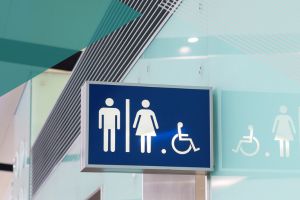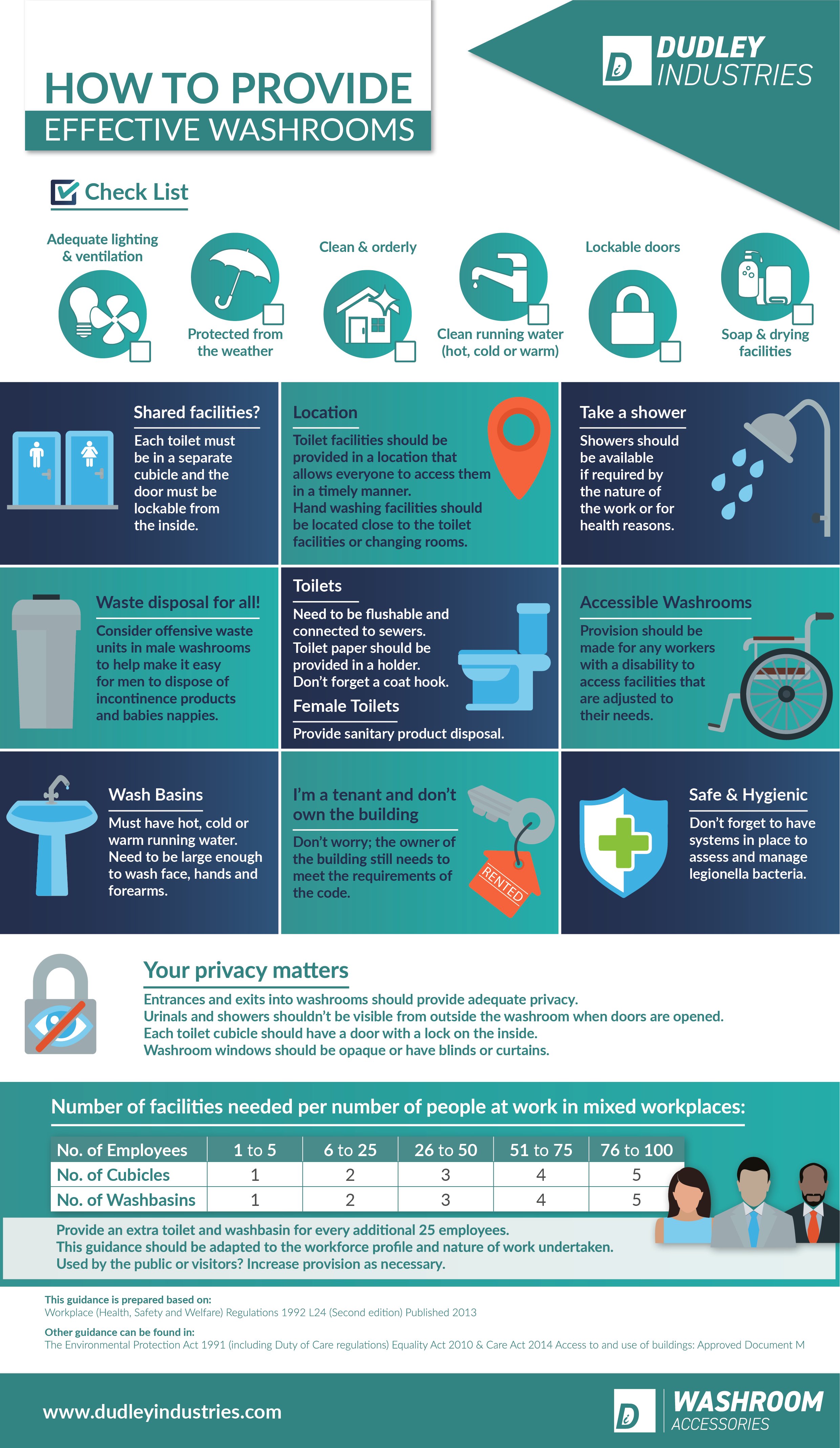How Many Washroom Dispensers Do Businesses Need?

February 5, 2024
Providing the right number of washroom dispensers and facilities is not only important to ensure you have enough facilities for your current and future staff, but also to ensure it is cost effective and fulfils your legal obligations.
The number of washroom dispensers you install, including paper towel dispensers, toilet roll dispensers, and sanitary products dispensers will vary depending on staff numbers, and projected number of total users including customers and visitors. The minimum number of toilet stalls you need is dictated by law, and this number will help you determine the number of dispensers required.
The importance of providing sufficient commercial washroom facilities
There are several reasons why you need to carefully consider how many washroom dispensers and user facilities your business needs, which we will address below.
Poor accessibility due to mismanaged washrooms can affect the efficiency and productivity of your workforce, and mean facilities become dirty and unhygienic more quickly, resulting in an increased need for essential cleaning and maintenance, and a potentially less pleasant user experience. Washrooms which are below capacity for the number of people using them may also face consumable issues, for example running out of toilet paper.
Legal requirements
When planning workplace commercial washrooms, you need to adhere to the Workplace (Health, Safety and Welfare) Regulations 1992, which outlines the basic number of sanitary conveniences and washing facilities a business should provide.
The Health and Safety Executive states that the minimum requirements for commercial washrooms are:
- Enough toilets and washbasins for those expected to use them - see table below
- Agreed reasonable adjustments for workers with disabilities, for example, a worker with prostate cancer
- Separate facilities for men and women, except where each toilet is in a separate room lockable from the inside
- Somewhere to dispose of menstrual items such as tampons or sanitary pads
- Clean facilities – preferably with walls and floors tiled (or covered in suitable waterproof material) to make them easier to clean
- A supply of toilet paper
- Facilities that are well lit and ventilated
- Hot and cold, or warm, running water
- Enough soap or other washing agents
- A basin large enough to wash hands, and forearms if necessary
- A way of drying hands, such as paper towels or a hot-air, working dryer
- Showers where necessary, for particularly dirty work
How to calculate the number of washroom facilities you need
Whilst the Workplace Regulations 1992 outline the minimum number of facilities, more facilities may be necessary, particularly if breaks are taken at set times, if establishments (such as production facilities) have peak times, or if workers finish work together and need to wash before leaving. Peak times can apply to a wide range of verticals, for example cinemas, sports and event centres and shopping centres. Businesses may see a large increase in users at certain times of day, such as train stations and motorway services, or at certain times of year such as bank holidays and Christmas.
Guidance for all washroom facilities should be adapted to the workforce/customer profile and nature of work/business undertaken.
Number of facilities needed per number of people at work in mixed workplaces
The following table shows the number of toilets and washbasins you are required to provide by law. The number of washroom dispensers you need to install, such as toilet roll dispensers and paper towel dispensers can be calculated from this.
|
Number of people at work |
Number of toilets |
Number of washbasins |
|
1-5 |
1 |
1 |
|
6-25 |
2 |
2 |
|
26-50 |
3 |
3 |
|
51-75 |
4 |
4 |
|
76-100 |
5 |
5 |
Number of facilities needed per number of males at work
These numbers are different to the table above because it is based on the number of urinals, rather than just cubicles. A urinal may either be an individual urinal or a section of urinal space of at least 600m long.
|
Number of people at work |
Number of toilets |
Number of urinals |
|
1-15 |
1 |
1 |
|
16-30 |
2 |
1 |
|
31-45 |
2 |
2 |
|
46-60 |
3 |
2 |
|
61-75 |
3 |
3 |
|
76-90 |
4 |
3 |
|
91-100 |
4 |
4 |
Additional toilets and washbasins
An additional toilet and washbasin should be provided for every 25 people.
For toilets only used by men, there should be an additional cubicle for every 50 men, provided at least an equal number of additional urinals are provided.
For dirty work which results in the heavy soiling of the face, hands and forearms, the number of washbasins should be increased to one for every 10 people at work up to 50 people, and one extra for every additional 20 people.
If facilities provided for workers are also used by members of the public, the number of toilets and washbasins specified above should be increased as necessary to ensure that workers can use the facilities without unreasonable delay.
Customer/employee satisfaction
While HSE provides a minimum number of facilities which must be adhered to, many organisations will choose to provide a larger number of facilities. This both minimises waiting times to provide a better experience and reduce time lost to queuing and waiting for facilities to come free, but also gives leeway for an increase in the workforce without having to make changes.
Ensure to minimise waiting time and improve customer satisfaction by providing enough facilities for the number of washroom users.
To provide a pleasant washroom environment you may wish to consider your washroom décor, and extra features available for each type of dispenser. Matching dispensers and a brushed metal finish are popular choices, as are touch free soap and paper towel dispensers for increased hygiene through reduced touch points.
Accessibility
Provision must be made for any worker with a disability to enable them to have access to facilities which are adjusted for their use if necessary. Not only will this show that your business is an inclusive environment, but this is also a legal requirement. You can read more about legal requirements for access to and use of buildings in the government produced Approved Document M.
Key considerations for your commercial washroom
Now that you have guidance on the number of facilities and dispensers you will need, here are key considerations to ensure your washrooms are compliant, accessible, and inclusive.
Toilets
Workplace toilets should be located in an accessible place where all users can easily reach them. The room must be well ventilated and lit.
Washroom cubicles
For shared facilities, each toilet must be in a separate cubicle and the door must be lockable from the inside.
Washroom toilets
Toilets need to be flushable and connected to sewers. Toilet paper should be provided in a holder or toilet roll dispenser. A coat hook is also stated in the regulations. Toilets should be kept in a clean and sanitary condition at all times, and checked regularly for damage and maintenance issues.
Sanitary hygiene
Suitable and sufficient sanitary conveniences should be provided at accessible places in your washroom. You must also provide a hygienic means for users to dispose of sanitary products.
Washing facilities
Commercial washing facilities also have minimum standards required of them.
Running water
Washbasins must have hot and cold, or warm running water. Basin and wash facilities must be large enough for users to wash their face, hands, and forearms. Showers should be provided where required.
Soap
Washing facilities aren’t considered to be suitable for use unless soap is provided. You may provide standard soap, soap dispensers, or other ways for users to practice good hand hygiene. Dudley Industries offer a wide range of soap dispensers in traditional and modern stainless steel finishes.
Hand drying
Adequate hand drying provisions, such as hand towels or alternative drying methods, are necessary for washing facilities to be considered suitable. While this may seem a straightforward request, there are a small number of considerations to bear in mind. Think about the day to day activities of your business, and consider if they will impact your choices.
For example: If your company practices require your staff and/or visitors to wash their face, such as may be required in the health and beauty industry, paper towels are likely to be more appropriate than a hand dryer. If you work in green industries, you may wish to look into the eco-friendly washroom options available to you.

Explore complete washroom solutions for every environment
Commercial washrooms are often high traffic areas which require hard wearing facilities. This practical requirement must be balanced with creating a clean and pleasant atmosphere for staff and customers alike. Dudley Industries provide a range of robust washroom dispensers in styles to suit any commercial environment. View the complete range and request a quote today.